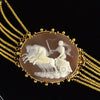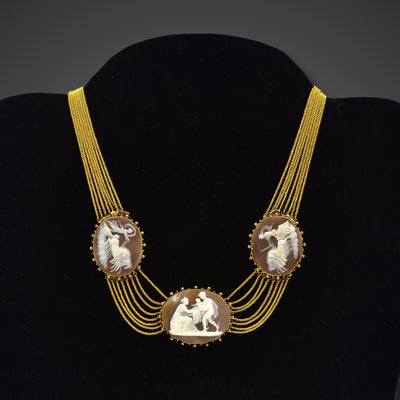Description
Neoclassical necklace made of 14k gold, set with three cameos cut from the precious Cassis Madegascariens shell. With mythological and classical scenes after the Danish sculptor Bertel Thorvaldsen. From left to right: Aurora (Eos), goddess of the dawn riding a two-wheeled chariot across the clouds in the sky with a burning torch to drive away the night. Hermes (Mercury), the messenger of the gods who brings the child Dionysius (Bacchus) to a nymph. Apollo, the most important male god after Zeus, shown in his golden chariot with four horses. A quiver of arrows dangles from his back.
Italy, 1770-1840 (Empire)
Neoclassicism was an art movement at the end of the 18th and the beginning of the 19th century that focused on examples from the ancient Greeks and Romans. Cameos and intaglios from this early period were fanatically collected in the 18th century by, among others, Empress Catherine of Russia. The carved stones slowly spread to fashionable jewelry at the beginning of the 19th century. Scenes from mythological stories were brought to attention with drawings and sculptures by artists such as Bertel Thorwaldsen from Denmark or the Englishman John Flaxman. Flaxman worked for the Wedgwood porcelain factory. Particularly in Italy, the neoclassical ideal image was converted into miniature. Precious seashells and corals were carved depicting gods and goddesses. A meticulously carved shell cameo was a prized possession. It is not surprising that the small works of art eventually ended up in jewelry. It combined beautifully with the graceful, thin white Baptist dresses that determined the fashion image.
Details
Details
Maker·niet gesigneerdPeriod·Georgian (1714 - 1830)Material·yellow goldWeight·50 gRef number·7178



















